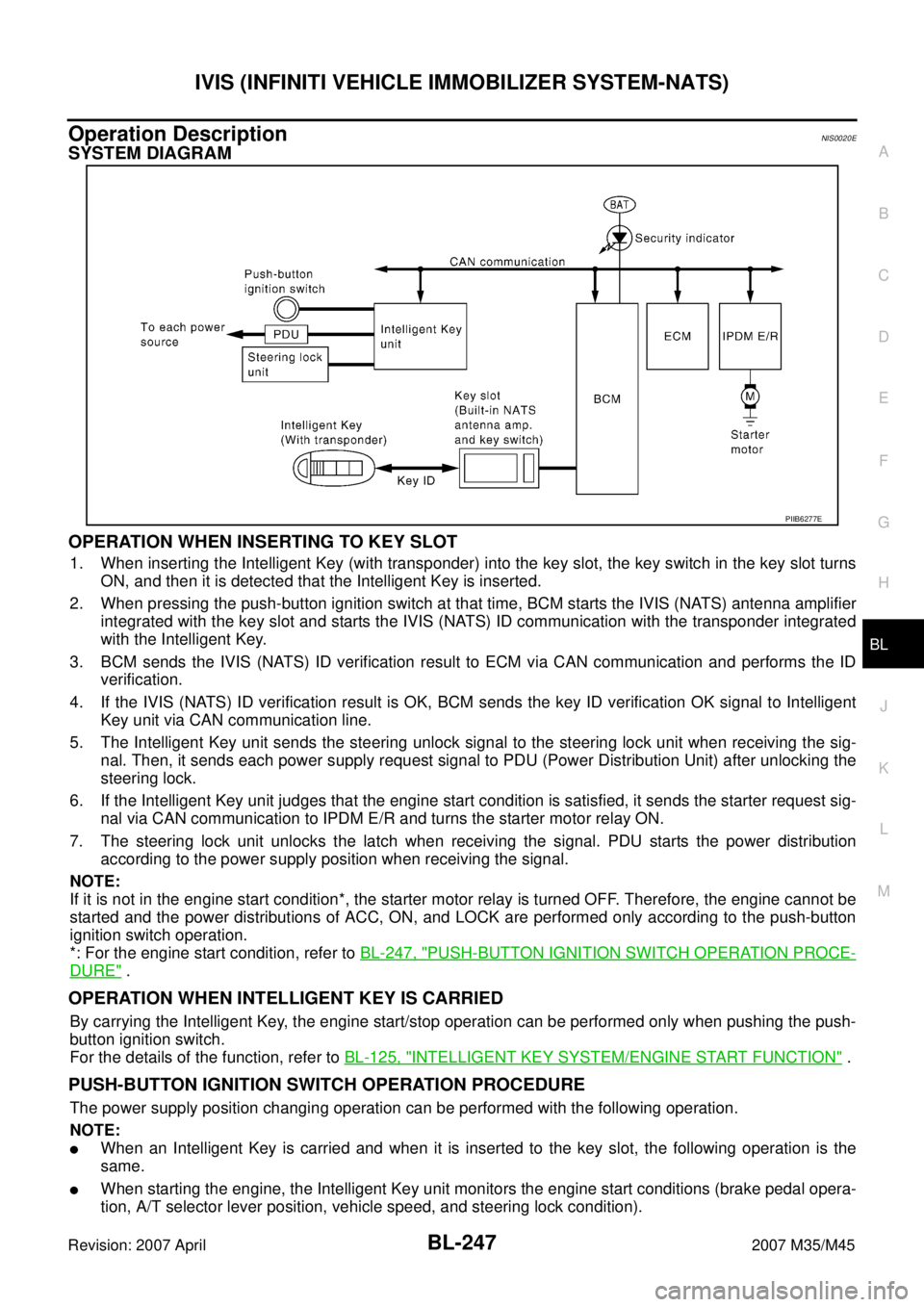Page 1142 of 4647
TRUNK LID OPENER
BL-209
C
D
E
F
G
H
J
K
L
MA
B
BL
Revision: 2007 April2007 M35/M45
Wiring Diagram —TLID—NIS001ZP
TIWT1301E
Page 1156 of 4647
VEHICLE SECURITY (THEFT WARNING) SYSTEM
BL-223
C
D
E
F
G
H
J
K
L
MA
B
BL
Revision: 2007 April2007 M35/M45
Wiring Diagram — VEHSEC —NIS001ZY
TIWT1305E
Page 1180 of 4647

IVIS (INFINITI VEHICLE IMMOBILIZER SYSTEM-NATS)
BL-247
C
D
E
F
G
H
J
K
L
MA
B
BL
Revision: 2007 April2007 M35/M45
Operation DescriptionNIS0020E
SYSTEM DIAGRAM
OPERATION WHEN INSERTING TO KEY SLOT
1. When inserting the Intelligent Key (with transponder) into the key slot, the key switch in the key slot turns
ON, and then it is detected that the Intelligent Key is inserted.
2. When pressing the push-button ignition switch at that time, BCM starts the IVIS (NATS) antenna amplifier
integrated with the key slot and starts the IVIS (NATS) ID communication with the transponder integrated
with the Intelligent Key.
3. BCM sends the IVIS (NATS) ID verification result to ECM via CAN communication and performs the ID
verification.
4. If the IVIS (NATS) ID verification result is OK, BCM sends the key ID verification OK signal to Intelligent
Key unit via CAN communication line.
5. The Intelligent Key unit sends the steering unlock signal to the steering lock unit when receiving the sig-
nal. Then, it sends each power supply request signal to PDU (Power Distribution Unit) after unlocking the
steering lock.
6. If the Intelligent Key unit judges that the engine start condition is satisfied, it sends the starter request sig-
nal via CAN communication to IPDM E/R and turns the starter motor relay ON.
7. The steering lock unit unlocks the latch when receiving the signal. PDU starts the power distribution
according to the power supply position when receiving the signal.
NOTE:
If it is not in the engine start condition*, the starter motor relay is turned OFF. Therefore, the engine cannot be
started and the power distributions of ACC, ON, and LOCK are performed only according to the push-button
ignition switch operation.
*: For the engine start condition, refer to BL-247, "
PUSH-BUTTON IGNITION SWITCH OPERATION PROCE-
DURE" .
OPERATION WHEN INTELLIGENT KEY IS CARRIED
By carrying the Intelligent Key, the engine start/stop operation can be performed only when pushing the push-
button ignition switch.
For the details of the function, refer to BL-125, "
INTELLIGENT KEY SYSTEM/ENGINE START FUNCTION" .
PUSH-BUTTON IGNITION SWITCH OPERATION PROCEDURE
The power supply position changing operation can be performed with the following operation.
NOTE:
�When an Intelligent Key is carried and when it is inserted to the key slot, the following operation is the
same.
�When starting the engine, the Intelligent Key unit monitors the engine start conditions (brake pedal opera-
tion, A/T selector lever position, vehicle speed, and steering lock condition).
PIIB6277E
Page 1185 of 4647
BL-252
IVIS (INFINITI VEHICLE IMMOBILIZER SYSTEM-NATS)
Revision: 2007 April2007 M35/M45
Wiring Diagram — NATS —NIS0020H
TIWT1324E
Page 1211 of 4647
BL-278
INTEGRATED HOMELINK TRANSMITTER
Revision: 2007 April2007 M35/M45
INTEGRATED HOMELINK TRANSMITTERPFP:96401
Wiring Diagram —TRNSCV—NIS0020V
TIWT2033E
Page 1302 of 4647

BRC-1
BRAKE CONTROL SYSTEM
F BRAKES
CONTENTS
C
D
E
G
H
I
J
K
L
M
SECTION BRC
A
B
BRC
Revision: 2007 April2007 M35/M45
BRAKE CONTROL SYSTEM
VDC/TCS/ABS
PRECAUTIONS .......................................................... 3
Precautions for Supplemental Restraint System
(SRS) “AIR BAG” and “SEAT BELT PRE-TEN-
SIONER” .................................................................. 3
Precautions for Procedures without Cowl Top Cover ..... 3
Precautions for Brake System .................................. 3
Precautions for Brake Control .................................. 4
PREPARATION ........................................................... 5
Special Service Tools ............................................... 5
Commercial Service Tools ........................................ 5
ON-VEHICLE SERVICE ............................................. 6
Adjustment of Steering Angle Sensor Neutral Posi-
tion ........................................................................... 6
SYSTEM DESCRIPTION ............................................ 7
System Diagram ....................................................... 7
Functions .................................................................. 7
ABS ....................................................................... 7
EBD ....................................................................... 7
TCS ....................................................................... 8
VDC ....................................................................... 8
ECD ....................................................................... 8
Operation That Is Not "System Error" ...................... 8
ABS ....................................................................... 8
TCS ....................................................................... 8
VDC ....................................................................... 8
Hydraulic Circuit Diagram ........................................ 9
CAN Communication ................................................ 9
SYSTEM DESCRIPTION ...................................... 9
TROUBLE DIAGNOSIS ............................................ 10
Fail-Safe Function .................................................. 10
ABS, EBD SYSTEM ............................................ 10
VDC/TCS ............................................................ 10
How to Perform Trouble Diagnoses ....................... 10
BASIC CONCEPT ............................................... 10
DIAGNOSIS FLOW CHART ................................ 11
ASKING COMPLAINTS ...................................... 12
EXAMPLE OF DIAGNOSIS WORKSHEET ........ 12
Component Parts Location ..................................... 13
Schematic .............................................................. 14Wiring Diagram — VDC — ..................................... 15
Control Unit Input/Output Signal Standard ............. 21
REFERENCE VALUE FROM CONSULT-II ......... 21
CONSULT-II Functions (ABS) ................................ 23
CONSULT-II MAIN FUNCTION ........................... 23
CONSULT-II SETTING PROCEDURE ................ 23
Self-Diagnosis ........................................................ 24
OPERATION PROCEDURE ................................ 24
ERASE MEMORY ............................................... 24
DISPLAY ITEM LIST ........................................... 25
Data Monitor ........................................................... 28
OPERATION PROCEDURE ................................ 28
DISPLAY ITEM LIST ........................................... 28
Active Test .............................................................. 30
OPERATION PROCEDURE ................................ 30
TEST ITEMS ....................................................... 31
For Fast and Accurate Diagnosis ........................... 32
PRECAUTIONS FOR DIAGNOSIS ..................... 32
Basic Inspection ..................................................... 33
BASIC INSPECTION 1: BRAKE FLUID LEVEL,
LEAK INSPECTION AND BRAKE PAD .............. 33
BASIC INSPECTION 2: LOOSENESS OF
POWER SYSTEM TERMINALS AND BATTERY ... 33
BASIC INSPECTION 3: ABS WARNING LAMP,
BRAKE WARNING LAMP, VDC OFF INDICATOR
LAMP AND SLIP INDICATOR LAMP .................. 33
TROUBLE DIAGNOSIS FOR SYSTEM .................... 34
Wheel Sensor Circuit .............................................. 34
INSPECTION PROCEDURE .............................. 34
Engine System ....................................................... 36
INSPECTION PROCEDURE .............................. 36
ABS Actuator and Electric Unit (Control Unit) ........ 36
INSPECTION PROCEDURE .............................. 36
ABS Actuator and Electric Unit (Control Unit) Power
Supply and Ground Circuit ..................................... 37
INSPECTION PROCEDURE .............................. 37
ABS Motor and Motor Relay Circuit ........................ 38
INSPECTION PROCEDURE .............................. 38
Solenoid, VDC Change-Over Valve and Actuator
Relay Circuit ........................................................... 39
Page 1308 of 4647
![INFINITI M35 2007 Factory Service Manual SYSTEM DESCRIPTION
BRC-7
[VDC/TCS/ABS]
C
D
E
G
H
I
J
K
L
MA
B
BRC
Revision: 2007 April2007 M35/M45
SYSTEM DESCRIPTIONPFP:00000
System DiagramNFS000Q5
FunctionsNFS000Q6
ABS
�Anti-Lock Brake System is a INFINITI M35 2007 Factory Service Manual SYSTEM DESCRIPTION
BRC-7
[VDC/TCS/ABS]
C
D
E
G
H
I
J
K
L
MA
B
BRC
Revision: 2007 April2007 M35/M45
SYSTEM DESCRIPTIONPFP:00000
System DiagramNFS000Q5
FunctionsNFS000Q6
ABS
�Anti-Lock Brake System is a](/manual-img/42/57024/w960_57024-1307.png)
SYSTEM DESCRIPTION
BRC-7
[VDC/TCS/ABS]
C
D
E
G
H
I
J
K
L
MA
B
BRC
Revision: 2007 April2007 M35/M45
SYSTEM DESCRIPTIONPFP:00000
System DiagramNFS000Q5
FunctionsNFS000Q6
ABS
�Anti-Lock Brake System is a function that detects wheel revolution while braking, electronically controls
braking force, and prevents wheel locking during sudden braking. It improves handling stability and
maneuverability for avoiding obstacles.
�Electrical system diagnosis by CONSULT-II is available.
EBD
�Electronic Brake force Distribution is a following function. ABS actuator and electric unit (control unit)
detects subtle slippages between the front and rear wheels during braking. Then it electronically controls
the rear braking force (brake fluid pressure) to reducing and reduces rear wheel slippage. Accordingly it
improves vehicle stability.
�Electrical system diagnosis by CONSULT-II is available.
1. Electric line 2. Brake hydraulic line 3. ECM
4. TCM 5. Steering angle sensor 6. Warning lamp, indicator lamp
(combination meter)
7. AWD control unit
(AWD models)8. ICC sensor integrated unit
(with ICC)9. RAS control unit
(with RAS)
10. Injector operation signal 11. CAN communication 12. Front RH wheel sensor
13. Front LH wheel sensor 14. Master cylinder 15. ABS actuator and electric unit (con-
trol unit)
16. VDC OFF switch 17. Yaw rate/side G sensor 18. Rear RH wheel sensor
19. Rear LH wheel sensor
SFIA2722J
Page 1310 of 4647
SYSTEM DESCRIPTION
BRC-9
[VDC/TCS/ABS]
C
D
E
G
H
I
J
K
L
MA
B
BRC
Revision: 2007 April2007 M35/M45
Hydraulic Circuit DiagramNFS000Q9
CAN CommunicationNFS000QA
SYSTEM DESCRIPTION
CAN (Controller Area Network) is a serial communication line for real time application. It is an on-vehicle mul-
tiplex communication line with high data communication speed and excellent error detection ability. Many elec-
tronic control units are equipped onto a vehicle, and each control unit shares information and links with other
control units during operation (not independent). In CAN communication, control units are connected with 2
communication lines (CAN H line, CAN L line) allowing a high rate of information transmission with less wiring.
Each control unit transmits/receives data but selectively reads required data only. Refer to LAN-50, "
CAN Sys-
tem Specification Chart" .
SFIA3049E